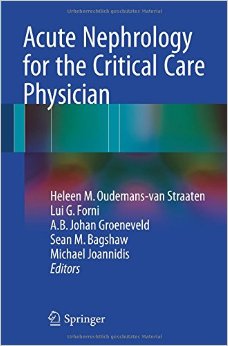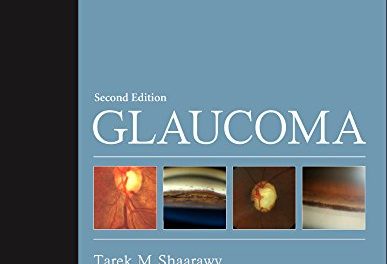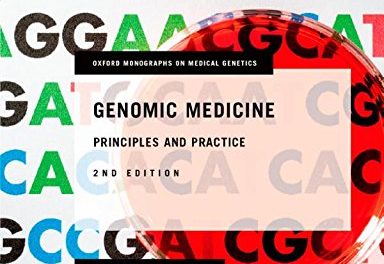 Authors and Editors: Heleen M. Oudemans-van Straaten, Lui G. Forni, A.B. Johan Groeneveld, Sean M. Bagshaw, and Michael Joannidis
Authors and Editors: Heleen M. Oudemans-van Straaten, Lui G. Forni, A.B. Johan Groeneveld, Sean M. Bagshaw, and Michael Joannidis
Publisher: Springer International Publishing – 286 pages
Book Review by: Nano Khilnani
Acute kidney-related problems as encountered by the critical care physician usually in the intensive care unit (ICU), and sometimes as part of multi-organ failure in the patient, are often quite challenging cases. This book provides you an overview of those problems and how to handle them well.
Some of the causes or attendant conditions of failure of multiple organs are the following:
- Cardiogenic or septic shock
- Systemic inflammation
- Following a major surgery
Acute kidney injury (AKI) typically causes serious damage, and increases the risk of morbidity and mortality for the patient. The editors emphasize in the Preface that awareness of the ongoing development of AKI is critical. They assert that the acute care physician or intensivist has a crucial role for optimal protection of the kidneys during serious illness.
They point out that the early recognition of the factors contributing to AKI are important skills for them to have, as is their decision-making on the prescription and delivery of high-quality renal replacement therapy (RRT). Although RRT is performed by the intensivist in close cooperation with the nephrologist (kidney specialist), the former has the global responsibility for the care of the patient because he has the integrated knowledge of the patient’s total condition.
A number of experts including the editors – from Australia, Canada, the United States, and Europe – share their wide-ranging knowledge, experience, and insight in this book, which consists of these 21 chapters in four Parts:
- Acute Kidney Injury
- AKI: Definitions and Clinical Content
- Epidemiology of AKI
- Renal Outcome After Acute Kidney Injury
- Etiology and Pathophysiology of Acute Kidney Injury
- Acid-Base
- Kidney-Organ Interaction
- Acute Kidney Injury in Pregnancy
- Diagnosis of AKI
- Classical Biochemical Work Up of the Patient
- Acute Kidney Injury Biomarkers
- Renal Imaging in Acute Kidney Injury\
- Prevention and Protection
- Prevention of AKI and Protection of the Kidney
- Renal Replacement Therapy
- Timing of renal Replacement Therapy
- Dose of Renal Replacement Therapy in AKI
- Type of Renal Replacement Therapy
- Anticoagulation for Continuous Renal Replacement Therapy
- Metabolic Aspects of CRRT
- Continuous Renal Replacement Therapy in Sepsis:
- Should We Use High Volume or Specific Membranes?
- Drug Removal by CRRT and Drug Dosing in Patients on CRRT
- Renal Replacement Therapy for Intoxications
- Pediatric CRRT
- Operational and Nursing Aspects
A simple organizational format is used in the chapters to make it easier for you the student or practitioner to understand and absorb the materials:
- Chapter title
- Bylines
- Topics and Subtopics
- A Single-Paragraph Introduction of Main Subject of Chapter
- Conclusion or Summary
- References
Let’s take a look at chapter 2, Epidemiology of AKI, authored by Ville Pettila, Sara Nasula, and Sean M. Bagshaw.
The main topic being discussed is Incidence of AKI: Population-Based Incidence. In the Single-Paragraph Introduction, the authors write that the incidence of AKI is influenced by which definition of AKI is used and the studied population.
They point to two studies. In the first retrospective study from Scotland representing a population 523,390 reported the population-based incidence of hospital-treated AKI as 214 per 100,000 a year. The second one, from one U.S. county area comprising a population of 124,277 reported a population-based incidence of 290 per 100,000 a year for ICU-treated AKI.
Another important and interesting topic covered in this chapter is Risk Factors Associated with AKI. In it the authors point out that several different predisposing factors and transient insults may affect the kidneys and lead to AKI. But they qualify that the risk for each patient to develop this condition depends:
- First on chronic conditions and patient-related factors
- Second on type and intensity of acute exposure and insults
In Table 2.1, Risk factors associated with AKI, these are the predisposing factors / chronic factors listed, probably arranged by the authors in order of importance:
- Advanced age
- Gender
- Black race
- Chronic kidney disease
- Diabetes mellitus
- Heart failure
- Pulmonary disease
- Chronic liver disease and/or complications of portal hypertension
- Proteinuria
- Hypertension
- Coronary artery disease
- Peripheral vascular disease
- Malignancy
- Genetic factors
- Acute diseases/drugs
- Severe sepsis
- Trauma
- Any critical illness
- Hypovolemia
- Anemia
- Any major surgery, e.g. cardiac surgery
- Radiocontrast media
- Fluid overload
- Synthetic colloids
- Chloride-rich solutions (i.e. 0.9% saline)
- Drug toxicity, drug interaction, or nephrotoxic medication
Editors:
Heleen M. Oudemans-van Straaten is in the Department of Intensive Care at VU University Hospital in Amsterdam, the Netherlands.
Lui G. Forni is in the Department of Intensive Care Medicine at Royal Surrey County Hospital NHS in Guilford, United Kingdom.
A.B. Johan Groeneveld is in the Department of Intensive Care at Erasmus Medical Center in Rotterdam, the Netherlands.
Sean M. Bagshaw is in the Department of Critical Care Medicine at University of Alberta in Edmonton, Alberta, Canada.
Michael Joannidis is in the Division of Intensive Care and Emergency Medicine in the Department of General Intensive Medicine at Medical University Innsbruck Anichstrasse in Innsbruck, Austria.







